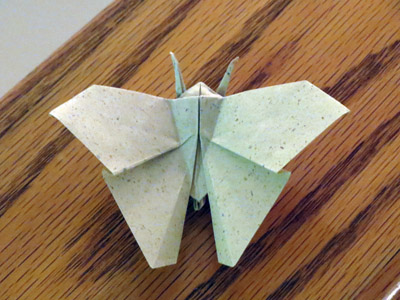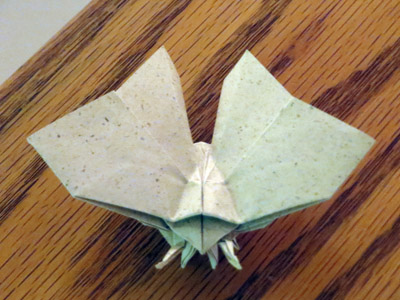I just got back from what’s becoming an annual autumn tradition: the MIT Origami conference, a.k.a OrigaMIT. First off, it’s a great time of year for a drive up to New England, with the leaves turning red and gold contrasted against all kinds of vivid, changing blue and grey skies.
This year was the best one yet. Thanks to Jason Ku and the MIT Origami Club for putting it all together. It’s grown to over 200 attendees, but still feels cozy and intimate. I saw a bunch of origami friends, although I didn’t have the chance to do more than say hi more than I would have liked. I exhibited a few “greatest hits” animals from my book, the one-sheet polyhedra from Uyen’s exhibit this summer, and a couple new models including my Single-Sheet Dual Interlocking Cubes with Color Change, and a new butterfly currently known as Butterfly III.
I don’t normally go to many classes at conventions, preferring mainly to teach and hang out, but this year I went to three. The first was Joseph Wu’s faces. Joseph is a great guy, creative, friendly and articulate, and I haven’t seen him in a few years because he’s on the west coast. Rather than teach a finished model, he taught his “face base” and then had the class freestyle to finish the model each in his own way, making creative discoveries along the way. His base focused on the nose and mouth, but the eye treatment was incomplete, so I began focusing on that. It was fun and interesting. I’ve had the idea to experiment with faces for a long time, but didn’t really have a good way in to get started. Seemed like a pretty big break from the other stuff I’m doing. Now I hope I can make the time to continue these explorations and develop something cool.
The second class I took was Paul Jackson’s one-fold origami. I’d never met Paul before, although I’ve been a big fan of his work and his style. Apparently he was in town for some other reason and it just happened to be the weekend of OrigaMIT. Paul comes from a design background, and the class was about minimalism (as you might expect), and using light and shadow, curved surface, and texture as design elements in origami, and examining closely what’s really going on with the paper, and developing an appreciation of these elements and a vocabulary for how to use them. From single-fold he went to partial-fold and finally to no-fold models. Like Joseph he railed against the tyranny of “the model” as the organizing principle and advocated for process, discovery, creative spontaneity, and exploring variations on a theme. As one data point for how far origami has come, back when I was in design school I did a few things that would now be classified as modular origami and tessellation origami, and at the time no one really got it. I thought it’d be funny to ask Paul if he had diagrams for any of his one-sheet models, but was able to restrain myself.
After lunch it was Erik Demaine’s lecture. He’s deep into reverse-engineering the life work of David Huffman, and inventing and proving all sorts of theorems about curved folding along the way. Neat stuff.
It was a lovely day and it’s always a treat for me to visit Boston, so I took a break in the middle of the day to go for a walk along the Charles river.
I spent the second half of the day teaching. First I class I taught was my Butterfly III. This is actually a set or series of models. It’s easy and natural for me when I’m designing for my thought process to run in streaks. After Joseph and Paul’s classes I decided that was a good theme for the day, and tried to bring that across in my class. The first variation of butterfly is low-intermediate. It’d be dead simple if not for a compound swivel fold to form the wings, but as it is it can be folding in five minutes. The interesting thing about the simple form is that begins folding the paper in half to form a rectangle. From there on it’s two layers thick and might as well be folded from half a sheet. But if you pull apart the layers at step 4 you get a whole nuther flap of paper that can be use to form the legs and antenna.
I also invented a bird using the same approach, but making the first fold on the diagonal rather than straight across. Using the same trick I can make it either with or without talons. I’ve been toying around with developing a two-headed eagle, and this looks promising as a base, although adding a second head changes the layout pretty radically.
My second class was my Mandela Tessellations. Strictly speaking these aren’t even really tessellations because they use polar rather than Cartesian coordinate geometry and they don’t tile a plane, just the area around a single point. Of course they could be extended to fill a plane, but that’s not the point of why I’m doing them. And again, keeping with the them of variation, I’ve developed two types, one with 8-fold symmetry (the Qadrose) and one with tenfold (the Penflower). I diagrammed both of these for the OrigaMIT convention collection. It was good to teach from diagrams, especially since the model has a lot of heavy prefolding. I spotted some places where the diagrams could be improved for clarity, and it’s always good to learn something when you teach a class. For the final, 3-D part I might add some detailed instructions to show more in-between steps, or maybe I’ll drop in some photos there when it’s time to publish it in a book. Meanwhile, you can enjoy the diagrams attached, and any feedback you have is always appreciated.
The evening was hanging out with origami friends. Brian Chan invited Jeannie and myself, along with a few other people, for a tour of MIT’s Hobby Shop, where he works. It’s a rather advanced machine shop full of CNC routers and water cutters and other fun stuff. Brian is building a fully functional Iron Man suit in his spare time there. He has a 3-D printer which he’s using to make parts for a new 3-D printer made as much as possible from 3-D printed parts. I guess there’ll come a day when he can press a button and start the singularity. Get ready!

